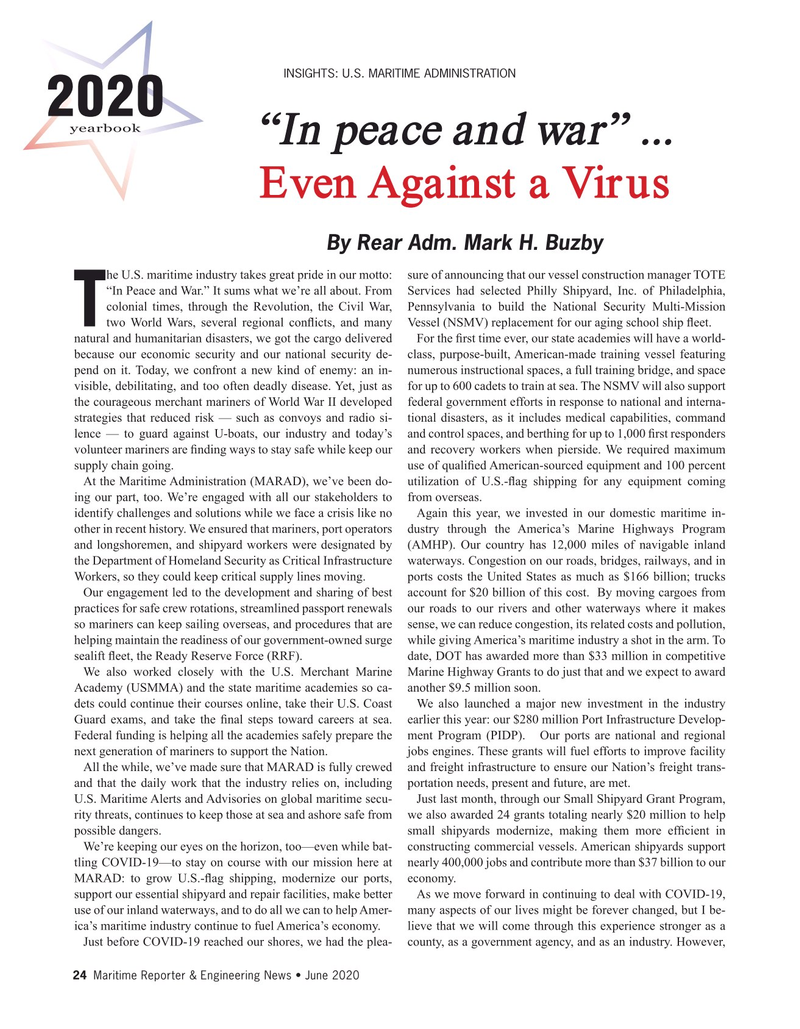
Page 24: of Maritime Reporter Magazine (June 2020)
2020 Yearbook
Read this page in Pdf, Flash or Html5 edition of June 2020 Maritime Reporter Magazine
INSIghtS: u.S. marItIme admINIStratIoN 2020 yearbook “In peace and war” ...
Even Against a Virus
By Rear Adm. Mark H. Buzby he U.S. maritime industry takes great pride in our motto: sure of announcing that our vessel construction manager TOTE “In Peace and War.” It sums what we’re all about. From Services had selected Philly Shipyard, Inc. of Philadelphia, colonial times, through the Revolution, the Civil War, Pennsylvania to build the National Security Multi-Mission
Ttwo World Wars, several regional conficts, and many Vessel (NSMV) replacement for our aging school ship feet.
natural and humanitarian disasters, we got the cargo delivered For the frst time ever, our state academies will have a world- because our economic security and our national security de- class, purpose-built, American-made training vessel featuring pend on it. Today, we confront a new kind of enemy: an in- numerous instructional spaces, a full training bridge, and space visible, debilitating, and too often deadly disease. Yet, just as for up to 600 cadets to train at sea. The NSMV will also support the courageous merchant mariners of World War II developed federal government efforts in response to national and interna- strategies that reduced risk — such as convoys and radio si- tional disasters, as it includes medical capabilities, command lence — to guard against U-boats, our industry and today’s and control spaces, and berthing for up to 1,000 frst responders volunteer mariners are fnding ways to stay safe while keep our and recovery workers when pierside. We required maximum supply chain going. use of qualifed American-sourced equipment and 100 percent
At the Maritime Administration (MARAD), we’ve been do- utilization of U.S.-fag shipping for any equipment coming ing our part, too. We’re engaged with all our stakeholders to from overseas.
identify challenges and solutions while we face a crisis like no Again this year, we invested in our domestic maritime in- other in recent history. We ensured that mariners, port operators dustry through the America’s Marine Highways Program and longshoremen, and shipyard workers were designated by (AMHP). Our country has 12,000 miles of navigable inland the Department of Homeland Security as Critical Infrastructure waterways. Congestion on our roads, bridges, railways, and in
Workers, so they could keep critical supply lines moving. ports costs the United States as much as $166 billion; trucks
Our engagement led to the development and sharing of best account for $20 billion of this cost. By moving cargoes from practices for safe crew rotations, streamlined passport renewals our roads to our rivers and other waterways where it makes so mariners can keep sailing overseas, and procedures that are sense, we can reduce congestion, its related costs and pollution, helping maintain the readiness of our government-owned surge while giving America’s maritime industry a shot in the arm. To sealift feet, the Ready Reserve Force (RRF). date, DOT has awarded more than $33 million in competitive
We also worked closely with the U.S. Merchant Marine Marine Highway Grants to do just that and we expect to award
Academy (USMMA) and the state maritime academies so ca- another $9.5 million soon.
dets could continue their courses online, take their U.S. Coast We also launched a major new investment in the industry
Guard exams, and take the fnal steps toward careers at sea. earlier this year: our $280 million Port Infrastructure Develop-
Federal funding is helping all the academies safely prepare the ment Program (PIDP). Our ports are national and regional next generation of mariners to support the Nation. jobs engines. These grants will fuel efforts to improve facility
All the while, we’ve made sure that MARAD is fully crewed and freight infrastructure to ensure our Nation’s freight trans- and that the daily work that the industry relies on, including portation needs, present and future, are met.
U.S. Maritime Alerts and Advisories on global maritime secu- Just last month, through our Small Shipyard Grant Program, rity threats, continues to keep those at sea and ashore safe from we also awarded 24 grants totaling nearly $20 million to help possible dangers. small shipyards modernize, making them more effcient in
We’re keeping our eyes on the horizon, too—even while bat- constructing commercial vessels. American shipyards support tling COVID-19—to stay on course with our mission here at nearly 400,000 jobs and contribute more than $37 billion to our
MARAD: to grow U.S.-fag shipping, modernize our ports, economy. support our essential shipyard and repair facilities, make better As we move forward in continuing to deal with COVID-19, use of our inland waterways, and to do all we can to help Amer- many aspects of our lives might be forever changed, but I be- ica’s maritime industry continue to fuel America’s economy. lieve that we will come through this experience stronger as a
Just before COVID-19 reached our shores, we had the plea- county, as a government agency, and as an industry. However, 24 Maritime Reporter & Engineering News • June 2020

 23
23

 25
25
